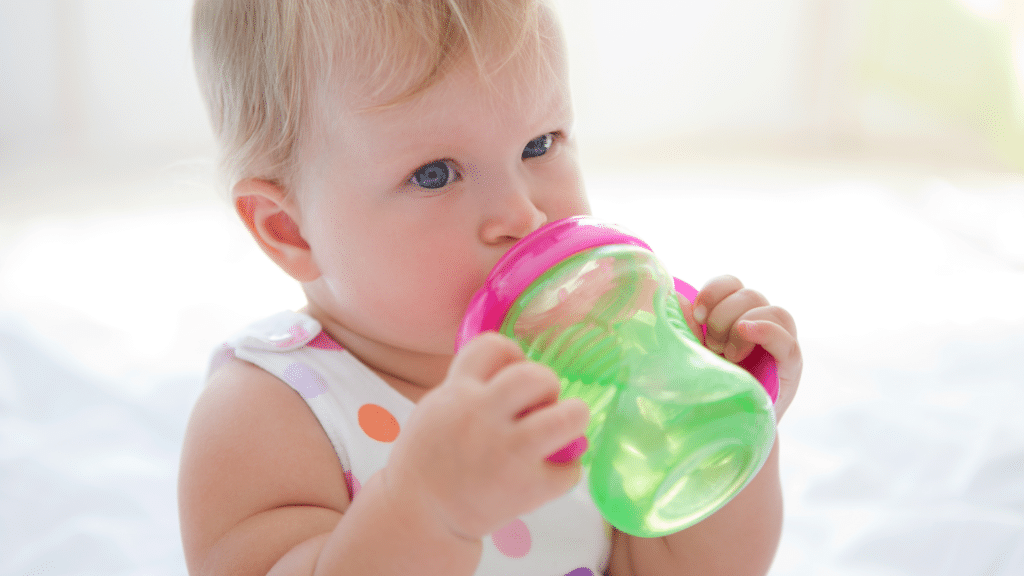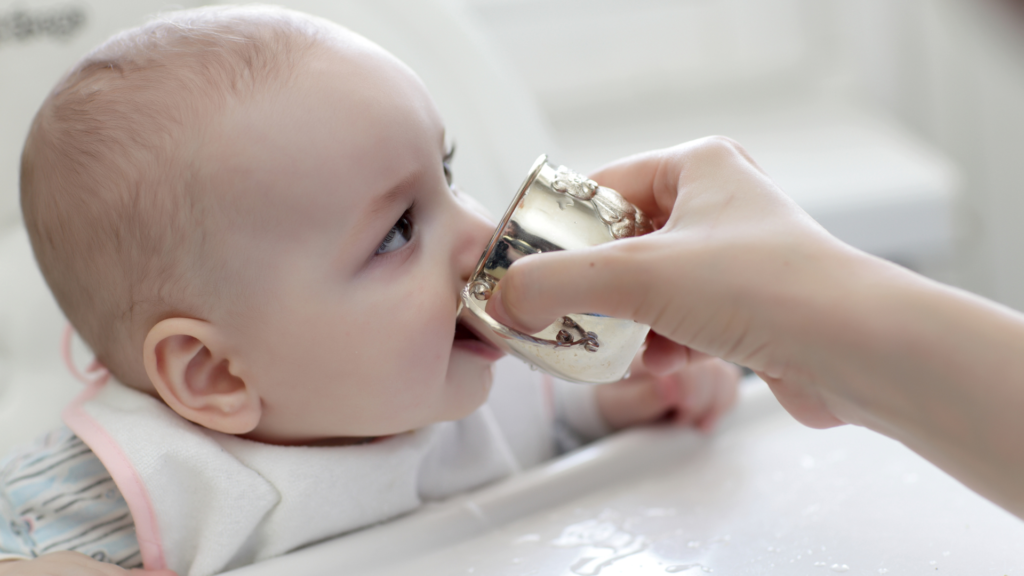When it comes to feeding our little ones, the primary role of breastmilk or formula in early infancy is undisputed. These rich sources of nutrition support the baby’s healthy development and growth in this critical stage of their life. But as they grow, there inevitably comes a time when the intake of water becomes a necessary addition to their diet.
This blog will take you through the journey of transitioning your baby to water, helping you navigate this significant milestone with confidence and care.

The Exclusive Feeding Phase
Exclusive breastfeeding for the first six months of a baby’s life provides all the essential nutrients required for their growth and development. Some key nutritional advantages of breastfeeding include:
Tailored Nutrients:
Breastmilk is specifically formulated to meet the unique nutritional needs of the baby, including proteins, fats, carbohydrates, vitamins, and minerals. This natural nutrition is preferred over baby formula to avoid potential cow’s milk allergy.
Easily Digestible:
The nutrients in breast milk are easily broken down and absorbed by the baby’s digestive system, better than soy milk or whole cow’s milk.
Boosted Immunity:
Breastmilk contains antibodies and immune-boosting cells that help protect the baby from illnesses and infections.
Promotes Gut Health:
Breastmilk is a rich source of probiotics and prebiotics, promoting the growth of healthy gut bacteria essential for the baby’s overall well-being.
Benefits for Growth and Development
Breastmilk promotes optimal growth and development, offering the following advantages to the baby:
- Cognitive development: Breastfeeding supports brain development due to the presence of essential fatty acids, such as DHA and ARA.
- Emotional development: The bond that develops through breastfeeding helps in promoting a sense of security and nurturing emotional development.
- Physical development: Breastfeeding promotes healthy weight gain, reduces the risk of childhood obesity and helps avoid baby bottle tooth decay caused by frequent exposure to natural sugars in formula fed infants or premature introduction of plain milk and other sugary liquids.
At around six months, it’s typically time to introduce solid foods to complement breastmilk or formula. It’s also important to note that after their first birthday, you may offer your child plain water as just a drink, and consider incorporating whole milk into their diet if they aren’t allergic. However, careful consideration should be made regarding these transitions to avoid issues such as tooth decay.
Signs of Readiness for Water Introduction
Let’s discern the physical and developmental cues that indicate a baby’s readiness for the introduction of water. It’s important to note that the American Academy of Pediatrics (AAP) recommends not introducing water until babies are about six months old.

Physical and Developmental Cues
While the six-month guideline is the general rule for water introduction, individual readiness signs can vary. Here are some cues that may point toward a baby’s readiness for water:
- Sitting up unassisted: Your baby should be able to sit up by themselves, showing sufficient muscle control needed for drinking.
- Chewing motions: The baby should start displaying chewing motions, indicating their readiness to handle more than just breast milk or formula.
- Showing interest in your food and drinks: Babies often show their readiness by observing you while eating or drinking and even trying to grab your utensils.
- Growth and weight gain: By six months, most infants have doubled their birth weight, another sign that their dietary needs may start to change.
Misconceptions About Early Water Introduction
Despite these cues, it’s essential to address some common misconceptions regarding the early introduction of water in a baby’s diet:
- Water to quench thirst: Unlike adults, babies do not need extra water to quench their thirst. Under six months, babies get all the hydration they need from breast milk or formula.
- Water for constipation: While it’s believed that water might help with constipation, babies should continue with breastmilk or formula under six months. If your baby is having trouble with bowel movements, consult a pediatrician.
- Water on hot days: It might seem logical to give babies water on hot days. However, increasing the frequency of breastfeeding or formula feeding meets their hydration needs.
Choosing the Right Time to Introduce Water
According to the American Academy of Pediatrics (AAP) and the World Health Organization (WHO), the right time to introduce water to an infant’s diet is when they are about six months old. At this age, the baby’s digestive system has developed enough to process water in addition to its main source of nutrition, be it breastmilk or formula.
Factors Influencing the Timing of Water Introduction
While the six-month guideline serves as a general rule, some factors might cause the timing of water introduction to be different for individual babies. These factors include:
- Climate: In hotter climates, the baby may face a higher risk of dehydration. Consult your pediatrician for guidance on whether to introduce water earlier to compensate for heat-related fluid loss.
- Introduction of solid foods: Once a baby begins consuming solid foods, their need for additional hydration increases. The introduction of water can coincide with the introduction of solid foods around six months.
- Breastfeeding frequency: If the breastfeeding frequency decreases significantly due to the mother’s work, health, or other commitment-related reasons, the baby might require supplementary hydration in the form of water, as recommended by a pediatrician.
- Baby’s medical condition: Some medical conditions might affect a baby’s fluid intake or metabolism. In such cases, always follow the pediatrician’s recommendation on introducing water or adjusting a baby’s fluid intake.
Remember, it is vital to consult your pediatrician for personalized advice tailored to your baby’s growth and development needs.

Importance of Gradual Transition
Gradual dietary transitions involve slowly introducing new food or liquid items into a baby’s diet, allowing them ample time to adjust. This typically involves several steps:
- Introduction: Introduce the new food or liquid slowly in small amounts.
- Observation period: Maintain a “waiting period” to observe any potential allergies or intolerances.
- Incremental Increase: Increase the quantity of the new food or liquid gradually over time.
- Variety introduction: Introduce new varieties only after the baby has adjusted to the previously introduced food or drink.
Introducing Water: The Gradual Approach
Introducing water into a baby’s diet follows this gradual transition approach:
- Start small: Begin by offering just a few sips of water a day from a sippy cup or spoon after the baby is around six months old.
- Observe: Watch for any potential adverse reactions, such as changes in stool pattern or appetite. Water should supplement the diet, not replace breast milk or formula feeds.
- Incrementally Increase: If all goes well, gradually increase the water intake up to about 2 to 4 ounces (60-120 ml) per day by their first birthday.
- Balance: Balance the introduction of water with the introduction of solids. As solid food intake increases, so can water intake due to the increased need for hydration.
By taking the gradual transition approach, parents and caregivers can ensure that their infants adjust to the introduction of water at a safe, healthy pace. Always ensure that the process is guided by your pediatrician’s advice and tailored to your infant’s growth and development requirements.
Ensuring Nutritional Balance
Keeping a sound nutritional balance for your baby is of utmost importance. The introduction of water shouldn’t compromise the intake of vital nutrients babies receive from breast milk or formula. This section introduces the importance and methods to maintain proper nutritional balance, even after water has been introduced into the diet.
Significance of Nutritional Balance after Water Introduction
Water serves as a useful supplement, not a replacement, for your baby’s primary diet. While it provides hydration, water doesn’t contain the essential nutrients found in breast milk or formula, such as proteins, carbohydrates, fats, vitamins, or minerals that form the cornerstone of a baby’s growth and development.
Monitoring Nutritional Balance
Here are some methods to ensure a balance between water and breastmilk/formula:
- Watch Feeding Volumes: Always ensure that water intake doesn’t cause a decrease in the volume of breast milk or formula your baby consumes. Record baby’s feed volumes to keep track.
- Observe Diaper Changes: Decreased wet or dirty diapers may suggest that the baby is consuming more water and less breastmilk or formula, thus getting fewer nutrients.
- Monitor Growth: Regular growth monitoring provides insight into whether the baby is getting enough nutrients from milk feeds. Any sharp decrease in growth velocity may indicate inadequate nutrition.
- Baby’s Behavior: Keep an eye on the baby’s behavior. Less active or unusually sleepy babies can be a sign of insufficient nutrition.
- Schedule: Schedule the intake of fluids wisely. Offering water after or in-between breastfeeding or formula feedings can ensure your baby consumes enough breast milk or formula.
Balancing Tips
Keep the following in mind to maintain the balance:
- Graduality: Start with a few sips of water and slowly increase its intake, ensuring it doesn’t affect milk feeds.
- Measure: Limit the amount of water to no more than 2 to 4 ounces (60-120 ml) per day by their first birthday.
Ensure to consult with your pediatrician regularly about your baby’s diet and whether they are receiving the right mix of nutrients. Nutritional balance will support your baby’s growth, development, and overall well-being.

Choosing the Right Tools for Water-Feeding
After understanding the right time and methods to introduce water to your baby, it’s equally pivotal to consider the utensils your baby uses for drinking water. These tools should facilitate the baby’s transition from breast or bottle feeding to drinking independently.
Introduce Sippy Cups
Around six months of age, as you introduce water and other supplementary feeds, you can begin to introduce a sippy cup. A sippy cup is a transitional tool before your child learns to drink from an open cup. It’s designed with a spill-proof spout that controls the flow of liquid, making it easier for the baby to learn drinking without spilling.
For initial stages, select a sippy cup with handles as babies, at this age, are still developing their gripping skills. Be mindful to choose cups made from non-toxic materials such as BPA-free plastics, stainless steel or glass. Moreover, your baby might not immediately accept the sippy cup, so patience is crucial.
Advance To Straw Cups
As your baby approaches their first birthday, they’ll likely be ready to start using a straw cup. The use of straw cups promotes mature swallowing patterns and oral muscle development. Plus, it’s easier to clean, minimizing the risk of mold build-up.
To help your baby get the hang of a straw: Cut a short piece of straw, dip it into water or breastmilk, cover the top to keep the liquid inside, and let your baby taste it. They will slowly understand that they need to suck to get the liquid out.
Open Cup Introduction
Around 12 to 18 months, you can gradually introduce an open cup. Start by giving them a small open cup during mealtimes to build their confidence and independence. Choose a small, lightweight cup to make it easier for the small hands to hold and control.
Keeping Hygiene in Check
In addition to choosing the right tool, hygiene is of utmost superiority. Unwashed cups can contain food particles that can foster the growth of bacteria and mold, posing potential harm to your baby’s health. Thus, it’s essential to wash the cups thoroughly after each use and allow them to air dry fully to avert any health hazards.
In conclusion, transitioning your baby from breast or bottle-feeding to drinking from a cup is a multifaceted process that involves recognizing the appropriate age, picking the correct tools and maintaining impeccable hygiene standards. Like any other developmental milestone, expect spills and messes but simultaneously keep in mind that every baby is unique in their pace of learning, so patience and constant guidance will pave the way for a seamless transition.
As always, when in doubt, consult your pediatrician to ensure you’re making the right decisions for your baby’s health and development.

Conclusion
In conclusion, adequately transitioning infants to water is a crucial milestone in their growth and development. The process begins around six months of age, coinciding with the introduction of solid foods. While water serves as a supplement to breast milk or infant formula, it is critical to maintain a proper nutritional balance to ensure a baby’s healthy upbringing.
The key aspects of a successful transition include recognizing the signs of readiness, discarding common misconceptions, considering individual factors, adopting a gradual approach, and ensuring nutritional balance. Always consult with your pediatrician for tailored guidance and monitor your baby’s growth and well-being closely during this significant transition. By following professional advice and understanding the importance of gradual dietary transitions, you can instill healthy habits in your baby’s life right from the start.
Did this article help you? Please comment below. If you have any questions, please don’t hesitate to ask.



